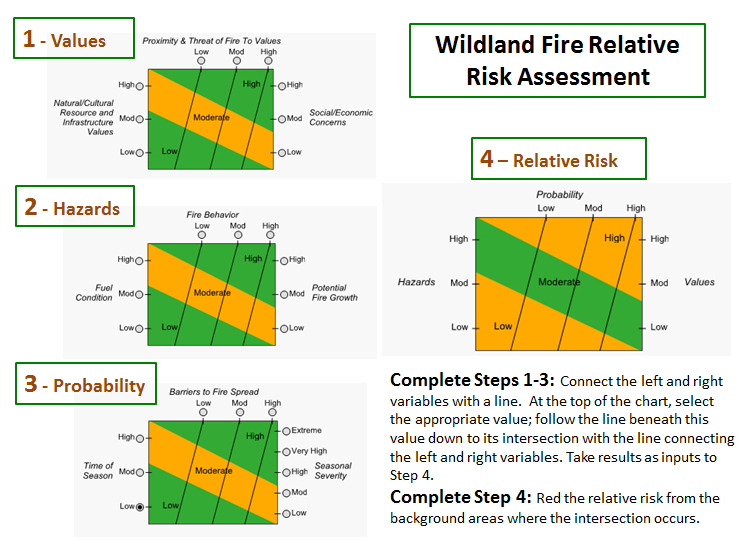Organization Assessment – Part 1: Relative Risk Assessment
Figure 1: Relative Risk Assessment Image

In WFDSS, users calculate the Relative Risk for an incident by selecting appropriate inputs for each of the above rating charts on the left. The inputs inform the Relative Risk rating in the chart on the right (4). See the Relative Risk Assessment guidance for descriptions of the variables in steps 1-3. If you had to develop a relative risk rating for an incident from a hard copy of the assessment, you would do the following:
- Select the appropriate radio button for each element in the Values rating chart.
- Draw a line connecting the selected radio button on the left and right sides of the chart.
- From the selected radio button at the top of the chart, follow the line down to where it intersects the line connecting the left and right sides of the graph.
- Read the Low, Moderate, or High rating from the background area where the intersection occurs.
- Do this for the Hazards and Probability rating charts as well.
- In the Relative Risk rating chart on the right, circle the Low, Moderate or High ratings derived from the three previous charts.
- Following the same sequence of line drawing steps (steps 2 & 3), determine the Relative Risk rating from the background area where the intersection occurs.
- Use relative risk result as inputs to Part 4: Organization Assessment.
Relative Risk Assessment
Values: Infrastructure/Natural/Cultural Concerns
Based on the number and kinds of values to be protected, and the difficulty to protect them, rank this element low, moderate, or high.
Considerations: Key resources potentially affected by the fire such as urban interface, structures, critical municipal watershed, commercial timber, developments, recreational facilities, power/pipelines, communication sites, highways, potential for evacuation, unique natural resources, special-designation areas, T&E species habitat, cultural sites, and wilderness.
Values: Proximity and Threat of Fire to Values
Evaluate the potential threat to values based on their proximity to the fire, and rank this element low, moderate, or high.
Values: Social/Economic Concerns
Evaluate the potential impacts of the fire to social and/or economic concerns, and rank this element low, moderate, or high.
Considerations: Impacts to social or economic concerns of an individual, business, community, or other stakeholder; other fire management jurisdictions; tribal subsistence or gathering of natural resources; air quality regulatory requirements; public tolerance of smoke; and restrictions and/or closures in effect or being considered.
Hazards: Fuel Conditions
Consider fuel conditions ahead of the fire and rank this element low, moderate, or high.
Evaluate fuel conditions that exhibit high rate of spread (ROS) and intensity for your area, such as those caused by invasive species or insect/disease outbreaks; continuity of fuels; low fuel moisture.
Hazards: Fire Behavior
Evaluate the current fire behavior and rank this element low, moderate, or high.
Considerations: Intensity; rates of spread; crowning; profuse or long-range spotting.
Hazards: Potential Fire Growth
Evaluate the potential fire growth, and rank this element low, moderate, or high.
Considerations: Potential exists for extreme fire behavior (fuel moisture, continuity, winds, etc.); weather forecast indicating no significant relief or worsening conditions; resistance to control.
Probability: Time of Season
Evaluate the potential for a long-duration fire and rank this element low, moderate, or high.
Considerations: Time remaining until a season ending event.
Probability: Barriers to Fire Spread
If many natural and/or human-made barriers are present and limiting fire spread, rank this element low. If some barriers are present and limiting fire spread, rank this element moderate. If no barriers are present, rank this element high.
Probability:. Barriers to Fire Spread
If many natural and/or human-made barriers are present and limiting fire spread, rank this element low. If some barriers are present and limiting fire spread, rank this element moderate. If no barriers are present, rank this element high.
Probability: Seasonal Severity
Evaluate fire danger indices and rank this element low/moderate, high, or very high/extreme.
Considerations: Energy release component (ERC); drought status; live and dead fuel moistures; fire danger indices; adjective fire danger rating; preparedness level.
Relative Risk Rating (Select One):
Low: Majority of items are Low, with a few items rated as Moderate and/or High.
Moderate: Majority of items are Moderate, with a few items rated as Low and/or High.
High: Majority of items are High; A few items may be rated as Low or Moderate.